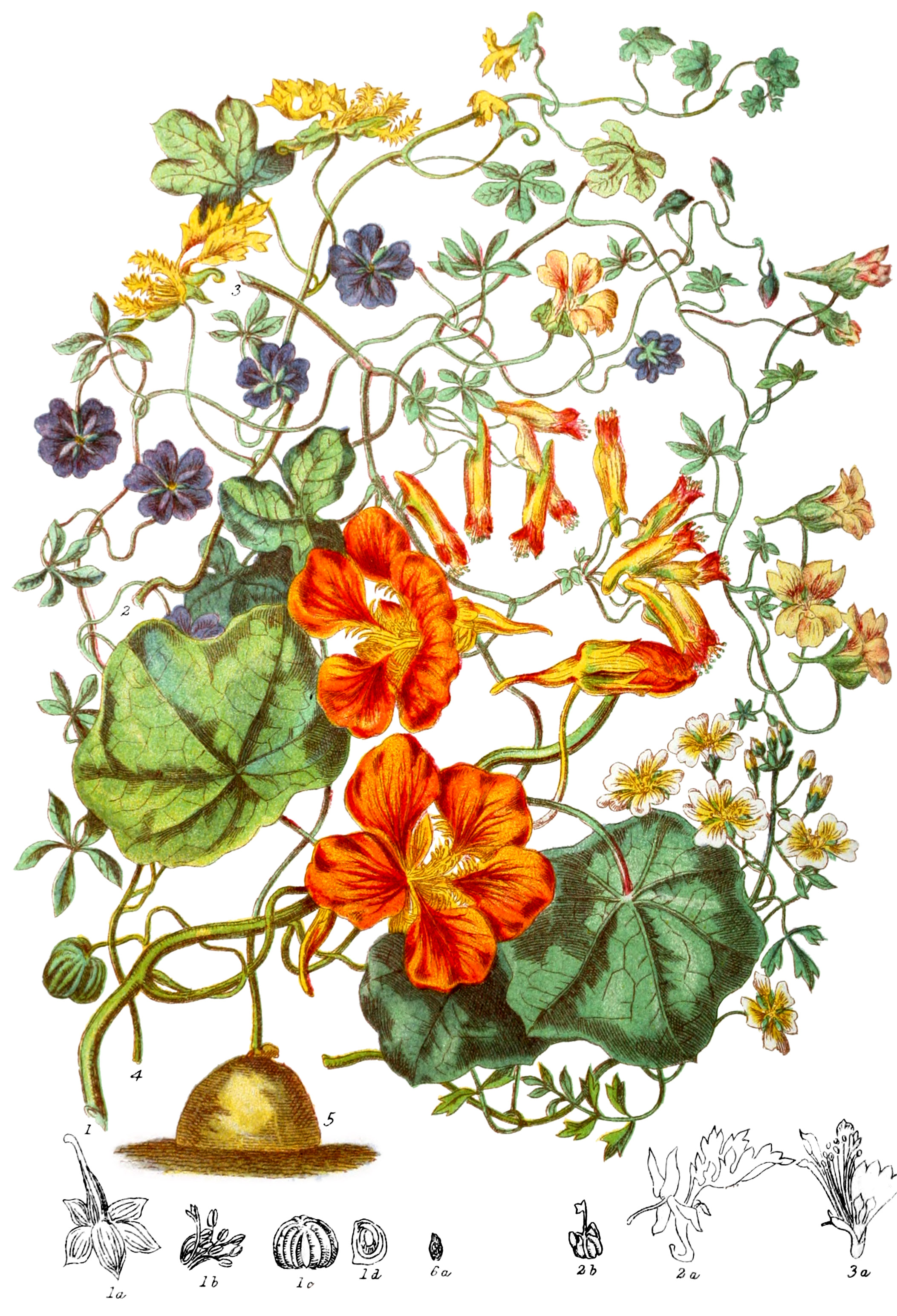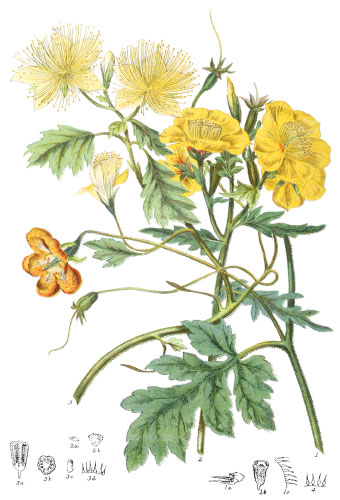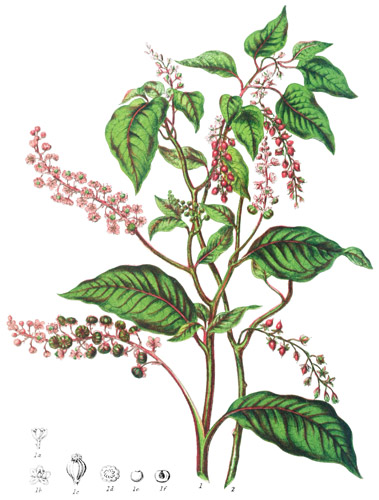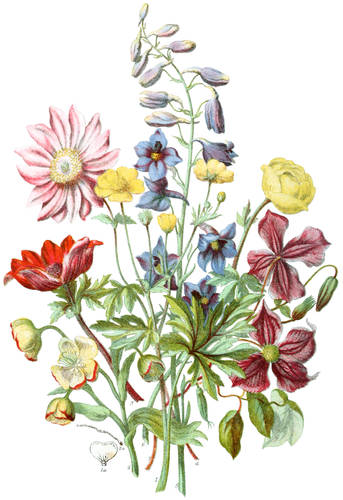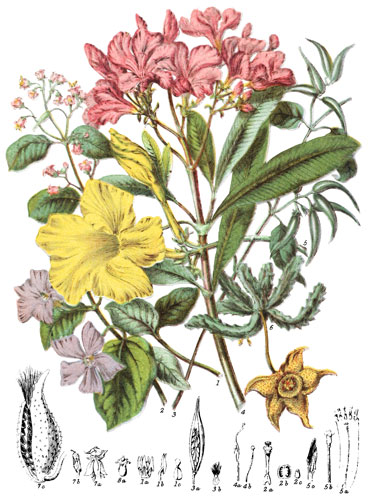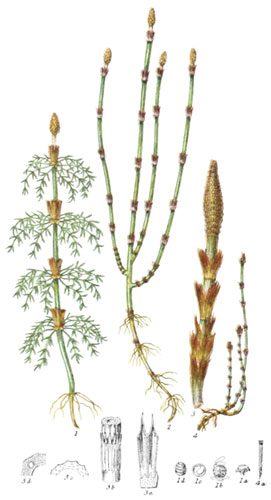Key characteristics
Smooth herbaceous plants, of tender succulent nature, trailing or twining, have an acrid taste. The leaves are alternate, without stipules, stalked, sometimes shield-shaped. The flower-stalks grow from the base of the leaf-stalks, and bear each one flower; the prevailing colour is orange. The sepals of the calyx are from three to five, the upper one having a long spur, distinct or connected at the base, sometimes coloured, in the bud they are usually closed in a valvular form, or are very slightly folded over. The petals are from one to five, of equal or unequal size, convolute in the bud, sometimes partially undeveloped, as in Tropæolum umbellatum (3); the stamens are from six to ten, inserted into the calyx, distinct, the anthers are two-celled. The ovary is simple, three cornered, composed of three or five carpels. The style is simple, the stigmas three or five, acute; the three parts of the fruit separate from the common axis, sometimes they are winged; the seeds are large, filling the whole carpel, without albumen.
This Order has affinity with the Mallow tribe, and is connected by many resemblances with Geraniaceæ, but the spur of Pelargonium is united to the flower-stalk.
An acrid property prevails in the leaves and fruit of these plants.
Select plants in this order
Not all plants listed are illustrated and not all plants illustrated are listed.
- The flower of Tropæolum is supposed to resemble a helmet, and the leaf has in some species the form of a buckler, from which the idea of a trophy was derived, and the Latin name composed.
- T. majus (1) is one of the most ornamental and hardy of the plants introduced from Peru, and is a very general favourite in gardens; the flowers, as well as the fleshy fruit, have a peculiar strong flavour, and are often eaten in salads or pickles. It is remarkable that this is the only plant besides those of the Cruciferous tribe on which the caterpillar of the Cabbage Butterfly feeds; this indicates the existence of similar properties to a certain extend.
- From the similarity of the flavour to that of Cress T. minus the first species introduced to Europe was named Nasturtium, after the water-cress: it was discovered by the Spaniards in Peru, and then followed the usual track in that time, first carried to Spain in the early part of the sixteenth century, thence transported to the gardens of Henry IV., in Paris, and afterwards sent over to England by the royal gardener Robin to his friend Gerard, who first cultivated this “rare and faire plant” in his garden, and called it “Cresses of India.” The daughter of Linnæus observed the property possessed by Tropæolum of emitting sparks in the twilight of midsummer morning and evening.
- T. tuberosum has an eatable tuberous root partly resembling the potato; on the slopes of the Andes, near Santiago, it is cultivated in large fields.
- T. edule (5) has a root of the same nature.
- T. peregrinum (2) was found by the Spaniards, a common climbing plant, in the gardens of Lima and other cities of Peru; they named it Paxaritos amarillos (yellow birds), and it is here frequently called Canary-flower, from the colour and remarkable shape of the flower when partially expanded; it was first brought over in 1775, but has only of late years been generally grown in gardens, having become perfectly hardy in our climate.
- T. azureum (4) is a singular example of a blue flower amongst a red and orange group.
- In T. umbellatum (3) the two petals attached to the spur are extremely minute.
- T. polyphyllum is a native of the Andes of Chile, near Mendoza.
- Magallana porifolia records the name of Ferdinant Magallan; in manner of growth and appearance, it closely resembles Tropæolum, the smooth round stems climbing and twining about; the leaves are in three slender divisions, and have numerous small pores; the remarkable part of the plant is the seed, which has three wide wings.
- Chymocarpus has a fleshy capsule.
- Limnanthes (6)* is an annual plant, the name derived from the Greek for lake and flower, in allusion to its place of growth; the parts of fructification vary a little from those of Tropæolum, and by some botanists it has been made the origin of a new Order, but the properties are precisely similar.
Locations
All these plants are natives of the Temperate regions of North and South America.
Legend
- Tropæolum majus, Great Nasturtium. Peru.
- Calyx.
- Stamens and Pistil.
- Capsule.
- Carpel and Ovule.
- Tropæolum peregrinum, Fringed Canary-Flower. Peru.
- Calyx and two Petals.
- Ovary and Pistil.
- Tropæolum umbellatum, Umbelled-flowered Tropæolum. Peru.
- Flower.
- Tropæolum azureum, Blue-flowered Tropæolum. Chile.
- Tropæolum edule. Peru.
- Limnanthes Douglassii. California.*
- *6 was not labeled in the original illustration.
- †6a was not named in the original description.
Explore more
Posters
Decorate your walls with colorful detailed posters based on Elizabeth Twining’s beautiful two-volume set from 1868.
Puzzles
Challenge yourself or someone else to assemble a puzzle of all 160 botanical illustrations.
